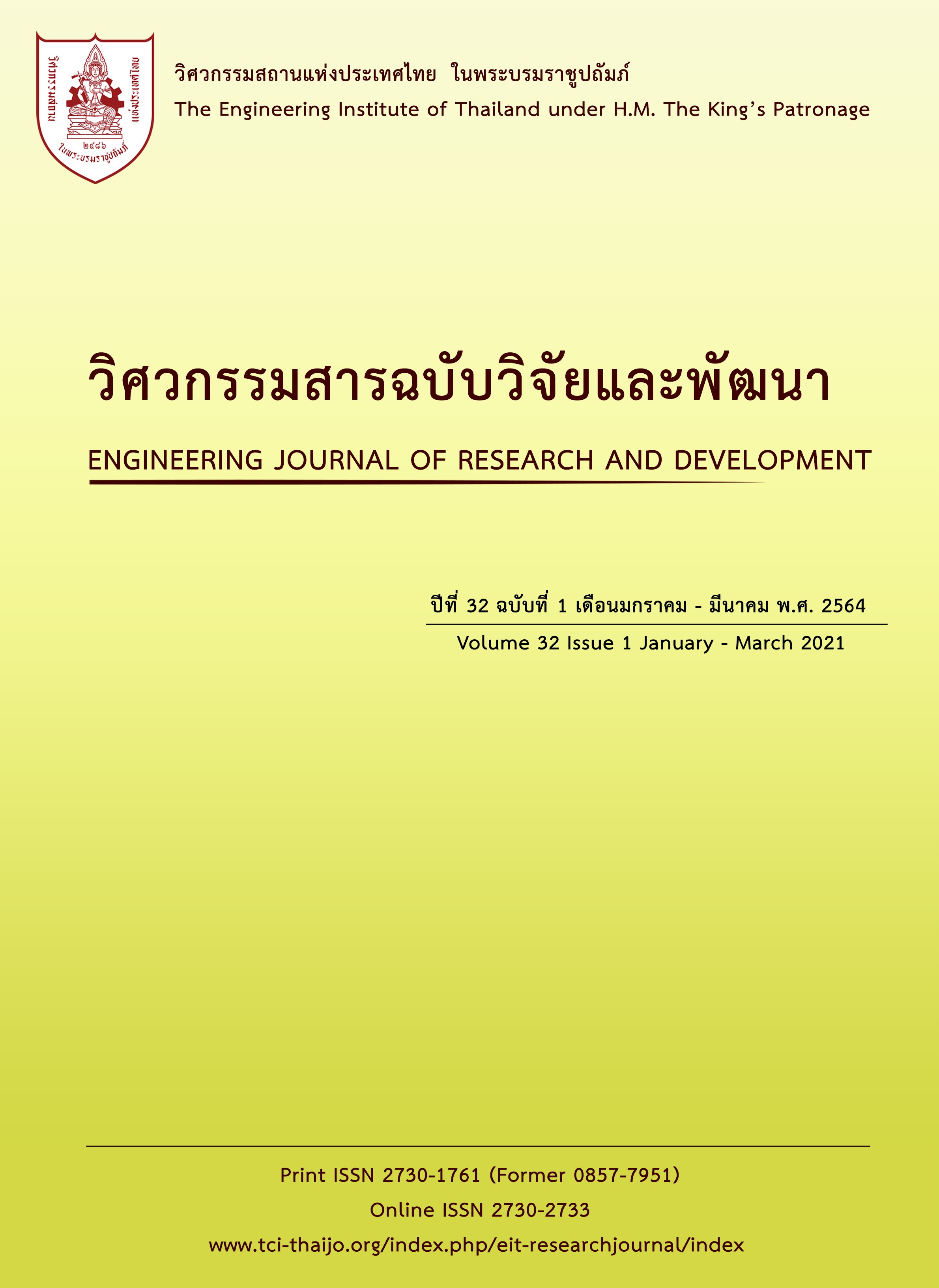PHYSICAL PROPERTIES OF GEOPOLYMER MORTAR PALM OIL FUEL ASH
Main Article Content
Abstract
This research studies the development for using palm oil fuel ash as a geopolymer material. This work presents a study of the compressive strength of geopolymer mortar containing ground palm oil fuel ash. Geopolymer mortar with constant liquid to palm oil fuel ash ratio and similar flow were used for the tests. Effects of temperature, delay time of curing, concentration of sodium hydroxide and sodium silicate to sodium hydroxide ratio on compressive strength were investigated. Test results indicate that, the workable flow of geopolymer mortar was in the range of 108–115% and was dependent on the ratio by mass of sodium silicate to NaOH and the concentration of NaOH. Extra water was used to improve the workability. The geopolymer mortars palm oil fuel ash good strengths was obtained with concentration of NaOH of 15M (15Molar, 15M) with the sodium silicate to NaOH ratio by weight of 2.5. The use of palm oil fuel ash produces geopolymer mixes with good strength were obtained with the delay time before subjecting the sample to heat was 1 h (Delay time) and the optimum curing temperature in the oven was 75 C with the curing duration of 1 day.
Article Details
The published articles are copyright of the Engineering Journal of Research and Development, The Engineering Institute of Thailand Under H.M. The King's Patronage (EIT).
References
[2] Bahurudeen, A. et al. Development of sugarcane bagasse ash based Portland pozzolana cement and evaluation of compatibility with superplasticizers. Construction and Building Materials, 2014, 68, pp. 465-475.
[3] Chindaprasirt, P. et al. Resistance to chloride penetration of blended Portland cement mortar containing palm oil fuel ash, rice husk ash and fly ash., Construction and Building Materials, 2008, 22(5), pp. 932-938.
[4] Chindaprasirt, P. et al. Use of palm oil fuel ash to improve chloride and corrosion resistance of high-strength and high-workability concrete. Journal of Materials in Civil Engineering, 2011, 23(4), pp. 499-503.
[5] Rukzon, S. and Chindaprasirt, P. Strength and chloride penetration of Portland cement mortar containing palm oil fuel ash and ground river sand, Computers and Concrete, 2009, 6(5), pp. 391-401.
[6] Chopra, D. et al. 2015, Strength, permeability and microstructure of self-compacting concrete containing rice husk ash. Biosystems Engineering, 2015, 130, pp. 72-80.
[7] Rukzon, S. and Chindaprasirt, P. Strength, porosity and chloride resistance of mortar using combination of two kinds of the pozzolanic materials. International Journal of Minerals, Metallurgy, and Materials, 2013, 20(8), pp. 808-814.
[8] Chalee, W. et al. 2013, Utilization of rice husk–bark ash to improve the corrosion resistance of concrete under 5-year exposure in a marine environment. Cement and Concrete Composites, 2013, 37, pp. 47–53.
[9] Rukzon, S. and Chindaprasirt, P. Strength, Chloride Penetration and Corrosion Resistance of Ternary Blends of Portland Cement Self-compacting Concrete Containing Bagasse Ash and Rice Husk-bark Ash. Chiang Mai Journal of Sciences, 2018, 45(4), pp. 863-1874
[10] Rukzon, S. and Chindaprasirt, P. Use of ternary blend of Portland cement and two pozzolans to improve durability of high-strength concrete. KSCE Journal of Civil Engineering, 2014, 18(6), pp. 1745-1752.
[11] Neville AM. Properties of concrete. 4th and Final Edition. Malaysia: Longman Group Limited; 1995.
[12] Rukzon, S. and Chindaprasirt, P. Utilization of bagasse ash in high-strength concrete. Materials and Design, 2011, 34, pp. 45-50.
[13] Rukzon, S. and Chindaprasirt, P. Strength and porosity of bagasse ash-based geopolymer mortar. Journal of Applied Sciences, 2014, 14(6), pp. 586-591.
[14] Chindaprasirt, P. et al. 2007, Workability and strength of coars high calcium fly ash geopolymer mortar. Cement and Concrete Composite, 29, pp. 224-229.
[15] Davidovits, J. et al. Chemistry of Geopolymeric Systems Terminology in Geopolymer ’99. International Conference, France, 1999, 1(1), pp. 9-40.
[16] Sathonsaopark, A. et al. Workability and strength of lignite bottom ash geopolymer morta., Journal of Hazardous Materials, 2009, pp. 168, 45-50.
[17] ASTM C33., 2005b, Standard Specification Concrete Aggregates. Annual Book of ASTM Standard, 04.02, 10-20.
[18] ASTM, C136. Standard Test Method for Sieve Analysis of Fine and Coarse Aggregates. Annual Book of ASTM Standard,2005c, 04.02, pp. 88-92.
[19] Awal, A.S.M. and Hussin, M. The effectiveness of palm oil fuel ash in preventing expansion due to alkali-silica reaction. Cement and Concrete Composites, 1997, 19(4), pp3 67-372.
[20] Coutinho, J.S. The combined benefits of CPF and RHA in improving the durability of concrete structures. Cement and Concrete Composites, 2003, 25(1), pp. 51-59.
[21] Dias, DP. and Thaumaturgo, C. Fracture toughness of geopolymeric concretes reinforced with basalts fibers. Cement and Concrete Composite, 2005, 27, pp. 49–54.
[22] Palomo, A. et al. Alkali-activated fly ashes: A cement for the future. Cement and Concrete Research, 1999, 8(29), pp. 1323-1329.


